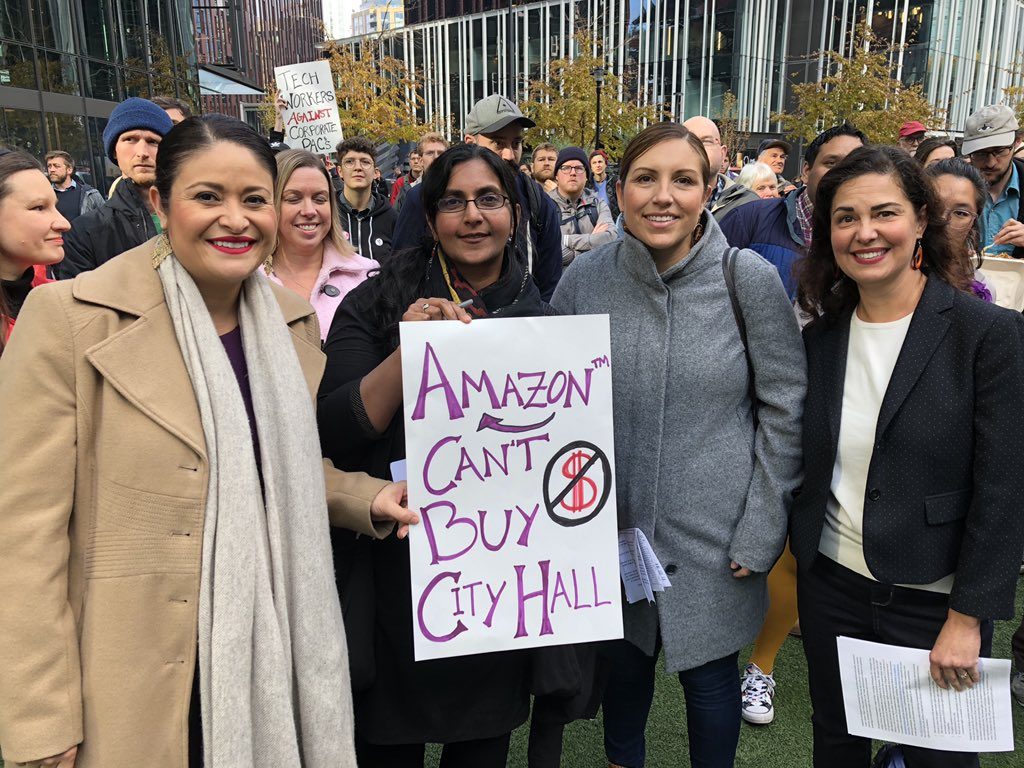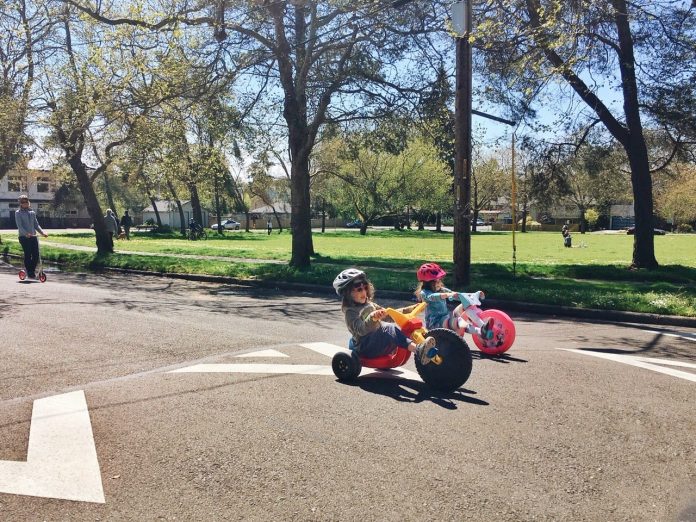The Jumpstart Seattle tax was a take-off-the-mask moment for Seattle that is still reverberating through Seattle politics.
Some would have us believe low taxes are more important than investments in the social safety net, the Green New Deal, and racial equity. They’d have you believe a progressive payroll tax on Seattle’s 700 largest companies would result in them packing up shop and heading to Bellevue or leaving the region entirely. And, moreover, if they did that, Seattle’s economy would sputter and it’d be like the Boeing Bust all over again with poor people ending up worse off, or so the argument goes.
Leaning on that story to prop up their case, Seattle’s business elite are trying to get even with the Seattle City Council over passing the Jumpstart progressive payroll tax, which is projected to pull in about $235 million next year. They have backed a slate of candidates (opposite of The Urbanist’s elections committee endorsements) who evade talk of new taxes and insist homelessness can be solved without new revenue — despite repeated studies stating that’s not the case, including a 2018 McKinsey study putting the annual cost for Seattle to solve homelessness at an additional $400 million at least. In 2020, McKinsey updated their report and pegged the needed investment into the $1 billion range.
McKinsey and Company is usually a go-to name in corporate consulting, but in this case Seattle business leaders have ignored the findings. In fact, the Seattle Metropolitan Chamber of Commerce is attempting to block Jumpstart with lawsuits — one of which already failed — and hijack homelessness policy with the Compassion Seattle charter amendment effort, which perpetuated the myth that homelessness can be solved without new funds but ultimately was struck down in court before it could appear on the ballot.
But low taxes and deference to big business is not the secret to Seattle’s success or its growth. Seattle grows because it’s a great place to live and it makes infrastructure investments other regions neglect. President Biden popularized the idea of social infrastructure in his jobs plan, emphasizing that things like child care, health care, and housing are infrastructure, just as much as transit, roads, and bridges. To its credit, Seattle has been investing more on a social infrastructure than many other American cities.
Downtown and South Lake Union are certainly economic engines, but look to the University District for what will keep Seattle outpacing its rivals. A major university nestled in a growing sea of skyscrapers but also surrounded by natural beauty and urban forests. Few university campuses can boast of being integrated into a dense urban environment while also being so near top-notch urban parks, state parks, and national parks as UW can. And its bold plans to grow its campus and boost enrollment by 20% will continue to ensure Seattle is where businesses want to be located to have access to that talented workforce.
Few places are adding rapid transit at a faster pace. Light rail just reached the U District, Roosevelt, and Northgate this month, linking them to Capitol Hill, the Downtown, Beacon Hill, Rainier Valley, and the airport. By 2024, extensions will reach Lynnwood, Shoreline, Federal Way, Bellevue, and Redmond. West Seattle Junction, Lower Queen Anne, Interbay, and Ballard will join the light rail mix in the 2030s.
For people seeking to live where they don’t need to own a car, Seattle is a highly attractive place given the strong and quickly improving transit options. Bike and pedestrian conditions have much room for improvement, but sadly even in their current state rank Seattle as one of the top-most walkable and bikeable cities in America. We see this proven out in national rankings and in census data, as Seattle is leading the nation in the formation of car-free households.
It’s clear some leaders get the secret to Seattle’s success better than others.

Council President Lorena González is running for mayor on a platform centered around taxing the rich to fund social housing, homelessness services, and infrastructure to make Seattle a 15-minute city. Being a 15-minute city means a resident can meet all of their family’s needs within a 15-minute walk, bike, or transit ride from home. This kind of systems thinking would help Seattle connect all the dots of good one-off safety projects that don’t quite form a cohesive and easy-to-use whole. It’s also a framework to draw attention where it’s most needed to redesign the dangerous status quo, such as the crash-prone streets of the Rainier Valley.
By contrast, former City Council President Bruce Harrell is talking about corporate philanthropy instead of corporate taxation and electric cars instead of bike lanes or transit, saying he “wouldn’t lead with bikes” at a recent debate, where he also said he was worried Seattle would lose businesses to Bellevue because of its tax policy. Harrell fought to keep the head tax (the predecessor to JumpStart) small and worked with Mayor Durkan to repeal it. He left the council before JumpStart deliberations, but one could imagine he would have reacted the same. If he, Durkan, and the Chamber has succeeded in blocking JumpStart, the city would have $235 million less to invest in its social infrastructure amidst a grueling pandemic. JumpStart already prevented a severe austerity budget last year, as Durkan proved herself better at spending JumpStart funds than she was at raising them. These lost opportunities would have hurt the city much more than theoretical corporate shrinkage will.
Nikkita Oliver, like González, is talking about transforming Seattle transportation and land use to be more equitable and climate-friendly in their inspiring campaign for Seattle City Council. They’re for adding sidewalks, bike lanes, bus lanes, increasing bus frequencies, and lowering transit fares.
Their opponent Sara Nelson has emphasized the status quo, wanting to keep single family zoning and failing to mention these key green transportation priorities in her environment plan, while managing to drop a bizarrely niche idea of “human-powered water transportation as a viable alternative mode of transport for people and goods” — essentially kayaks for commuting plus a dubious Lake Union passenger ferry.
Teresa Mosqueda was the lead author on JumpStart legislation and shepherded it through Council with a veto-proof majority, which was very useful as Mayor Durkan refused to sign the tax and attempted to veto the year one spend plan. She’s been a powerful advocate for pedestrianization efforts, bike lanes, and transit.
Mosqueda’s oppoent Kenneth Wilson’s main policy idea is to open the West Seattle Bridge while it’s still under construction under his hunch that such foolishness would be safe. His other obsession beyond Evil-Knievel style bridge openings and sweeping homeless encampments, is tree canopy protections, which is a very valid issue that he’s pretty clearly using as a not-in-my-backyard (NIMBY) dogwhistle.
A Seattle led by González, Mosqueda, and Oliver would be much different than one led by Harrell, Nelson, and Wilson. The latter would choose the path of appeasement to big business and reactionary homeowners. The progressive trio, meanwhile, understands Seattle’s secret to success is its people and the infrastructure that supports them, and they would invest accordingly. Let’s build something together rather than race to the bottom while bending over backwards for big business.
Doug Trumm is publisher of The Urbanist. An Urbanist writer since 2015, he dreams of pedestrian streets, bus lanes, and a mass-timber building spree to end our housing crisis. He graduated from the Evans School of Public Policy and Governance at the University of Washington in 2019. He lives in Seattle's Fremont neighborhood and loves to explore the city by foot and by bike.



